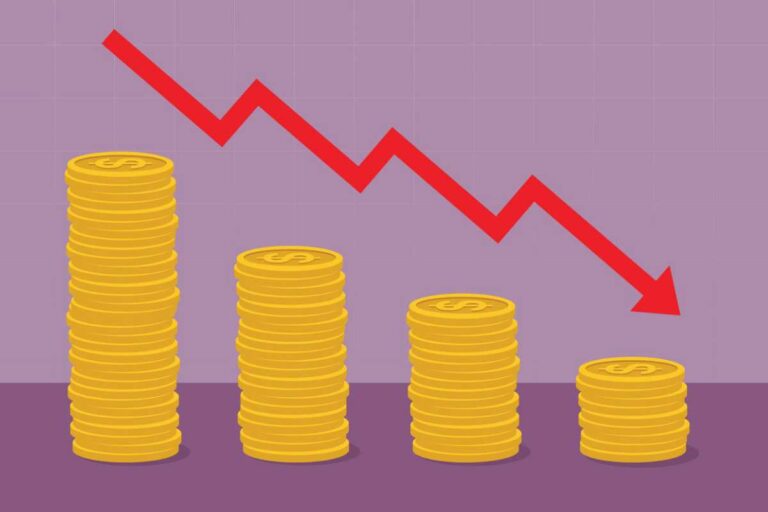Deflation: Meaning, causes, effects, prevention and more

Deflation is a phenomenon in economics where there is a general decrease in the prices of goods and services over a certain period. This can occur due to a variety of reasons such as a decrease in demand, an increase in production, or changes in monetary policies. Understanding the causes and effects of deflation is important in making informed economic decisions.
In this article, we will explore the definition, causes, and other important aspects of deflation.
What is deflation
Deflation is a decrease in the general level of prices of goods and services over a specific period. It is measured by the Consumer Price Index (CPI) or Producer Price Index (PPI), which are used to track changes in the prices of a basket of goods and services. When deflation occurs, the purchasing power of money increases, meaning consumers can buy more goods and services for the same amount of money.
Deflation is different from disinflation, which refers to a slower rate of increase in prices, rather than a decrease. It is also distinct from inflation, which is an increase in the general price level. Deflation is considered a negative economic indicator, as it can lead to a decline in consumer spending and a decrease in economic activity. In some cases, deflation can even lead to a deflationary spiral, where lower prices lead to lower demand, lower production, and further decreases in prices.
Causes of deflation
Deflation can occur due to a variety of reasons, some of which include:
- Decrease in demand: A decline in consumer demand for goods and services can result in lower prices, as suppliers are forced to lower their prices to clear their inventory. This can occur when people are uncertain about their future income or employment prospects, or if they are saving more and spending less.
- Increase in supply: An increase in the supply of goods and services can lead to lower prices, as suppliers compete to sell their products. This can occur when there are advancements in technology or an increase in productivity, leading to a greater supply of goods and services.
- Changes in monetary policy: Central banks can play a role in causing deflation by reducing the money supply or raising interest rates, which can lower the demand for goods and services. In some cases, this can lead to lower prices, as suppliers are forced to lower their prices to sell their products.
- International trade: Deflation can also occur as a result of international trade when imports increase and exports decrease. This can result in lower prices for goods and services, as suppliers are forced to lower their prices to compete with cheaper imports.
- Debt: High levels of debt can also lead to deflation, as consumers and businesses are forced to pay down their debt, leading to lower spending and lower demand for goods and services.
- Natural disasters: Natural disasters, such as droughts or earthquakes, can disrupt production and supply chains, leading to lower prices for goods and services.
Each of these factors can contribute to deflation in different ways, and it is often a combination of factors that leads to a general decrease in prices. Understanding the causes of deflation is important to effectively tackle the issue and prevent further economic decline.
Effects of deflation on the economy
Deflation can have far-reaching and negative effects on the economy, including:
- Decreased consumer spending: When prices are declining, consumers may delay purchases in the hope that prices will continue to fall, leading to a decrease in demand and a decline in economic activity.
- Decreased business investment: Businesses may also delay investments in new projects or equipment, as they are uncertain about future demand and prices. This can lead to a decrease in economic growth and job creation.
- Increased debt: Deflation can make it harder for consumers and businesses to pay off their debt, as the real value of their debt increases with falling prices. This can result in higher levels of debt and financial stress.
- Decreased profits: Lower prices can lead to lower profits for businesses, as they are forced to sell their products at a lower price. This can result in reduced investment and job cuts.
- Increased unemployment: The decline in economic activity and lower profits can result in increased unemployment, as businesses are forced to lay off workers.
- Deflationary spiral: In some cases, deflation can lead to a deflationary spiral, where lower prices lead to lower demand, lower production, and further decreases in prices. This can be difficult to escape from, as lower demand and lower prices can result in a self-reinforcing cycle.
Preventing and addressing deflation
Preventing and addressing deflation is important to maintain economic stability and prevent further economic decline. Some of the steps that governments and central banks can take to prevent and address deflation include:
- Implementing monetary policy: Central banks can take steps to increase the money supply and lower interest rates, stimulate demand and increase inflation. This can involve implementing quantitative easing, where the central bank buys government bonds and other assets to increase the money supply.
- Implementing fiscal policy: Governments can take steps to increase spending and stimulate demand, for example by increasing infrastructure spending, providing tax cuts, or increasing transfer payments.
- Encouraging lending: Encouraging lending by banks can help to increase demand for goods and services, and stimulate economic activity.
- Addressing structural issues: Addressing structural issues that may be contributing to deflation, such as high levels of debt, can help to prevent deflation and promote economic growth.
- Encouraging consumer confidence: Encouraging consumer confidence by providing a stable and predictable economic environment can help to stimulate demand and prevent deflation.
By taking these steps, governments and central banks can help to prevent and address deflation, and promote economic stability and growth. It is important to take these steps proactively, to prevent a deflationary spiral and maintain a healthy and growing economy.
The role of central banks in deflation
The role of central banks in deflation is crucial, as they play a key role in preventing and addressing deflation. Central banks have many tools at their disposal to prevent and address deflation, including:
- Monetary policy: Central banks can implement monetary policy to increase the money supply, lower interest rates, and stimulate demand. This can help to increase inflation and prevent deflation.
- Lender of last resort: Central banks can act as lenders of last resort, providing loans to banks during periods of financial stress to prevent a credit crunch and maintain stability in the financial system.
- Market operations: Central banks can engage in market operations, such as buying government bonds, to increase the money supply and lower interest rates.
- Communication: Central banks can use communication to influence expectations about future inflation, to encourage spending and investment, and prevent deflation.
Central banks have a critical role to play in preventing and addressing deflation, and their actions can have a significant impact on the economy. By taking proactive steps to prevent and address deflation, central banks can help to maintain economic stability and promote economic growth.
Conclusion
Deflation is a significant economic challenge that can have far-reaching consequences for an economy. Understanding the causes of deflation and the steps that can be taken to prevent and address it is crucial for maintaining economic stability and promoting growth.
Central banks play a key role in preventing and addressing deflation, and their actions can have a significant impact on the economy. By taking proactive steps to prevent and address deflation, governments, central banks, and other stakeholders can help to ensure a healthy and growing economy.
Don't miss a thing. Follow us on Telegram and Follow us on WhatsApp. If you love videos then also Subscribe to our YouTube Channel. We are on Twitter as MakeMoneyDotNG.





